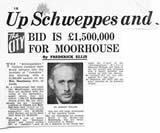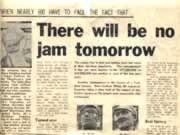 |
 |
| |
|
The Decision to sell out to Schweppes - Right or Wrong?
I was transferred to Schweppes, Marble Arch about one year after the merger. I worked for two years as personal assistant to A.F. Canfield, Group Production and Engineering Director. I therefore saw very senior management at a much earlier age than I might otherwise have expected. There is no doubt that Chivers and Hartley's had significantly more problems than Schweppes had expected. Schweppes then compounded the problems by assuming that what was good for the mineral water business would be good for the jam business. The following major decisions were made:- 1) A series of depots were built so that jams and other products could be trunked from the factories to the satellite depots for delivery. This was Schweppes method of delivery, in fact neither the trade nor the profit margins in the jam industry would support this double handling. With supreme irony on the day the last of the depots was opened, the first was being closed. 2) The Schweppes board were convinced that by improving the quality and image of jam its consumption, by this time falling significantly, could be re-established hence the large investment in Hartleys "New Jam" and the associated vacuum boiling plant installed at Histon. It was a superb plant, I ran it from 1967-1970, but the product never made money. 3) The new board decided that it was not consistent with the Schweppes image to be associated with bulk jam manufacture (7 and 28 lb containers) or "own label" jam manufacture. This decision sealed the fate of the Beeston factory. I think by then Aylesbury had been transferred to Schweppes juice bottling. There were other decisions which reflected the arrogant philosophy of Schweppes management "What we have successfully done with mineral waters we can do equally successfully with jam". This view might suggest that staying out of the merger with Schweppes would have paid dividends and indeed I believe it would have done - for three or four years. Whilst the family business at that time was a highly profitable business due to its superbly balanced product range. The Moorhouse label "England's Finest" was in both retail grocery and bulk bakery a highly profitable range. The own label business especially Sainsbury and Crosse & Blackwell jams was perhaps less profitable but provided huge volume throughput. In addition there was the mincemeat and Christmas pudding range, the bottled fruit, Christmas shopping bags and Peter Puddings. The factory space was used economically, apart from the jam boiling room almost all other areas were used for different products/purposes at different times of the year. However it has to be said that much of the plant was ageing and a great deal of investment in plant and buildings was going to be needed during the 1960's. Similarly retail grocery shops and small high quality bakers were disappearing to be replaced by supermarkets and multiple bakeries. The market for bottled fruit would disappear almost overnight; a further requirement for new plant and product investment. The supermarkets gained ever increasing buying power and extension to their credit terms. It was said that Jack Cohen financed each new store from the unpaid invoices of his suppliers (plus ca change). The supermarkets would list (stock) products which were truly national and whilst Moorhouses were almost national they were not totally national. The requirement for large marketing budgets was also coming to the fore. All in all whilst I believe that we would have made increasing profits for four or five years the sheer size of Schweppes/Chivers/Hartley and the financial muscle that they could bring to bear would have prevailed. At the time of the merger the Board could go to Schweppes as a highly profitable and efficient partner. Ultimately we would have had to have gone "cap-in -hand" to a prospective purchaser on a much less attractive profit basis.
Articles/
The decision to sell >
|


